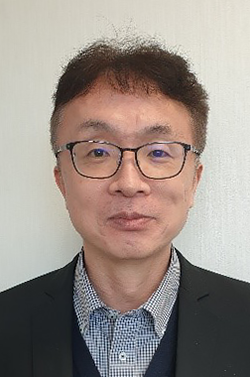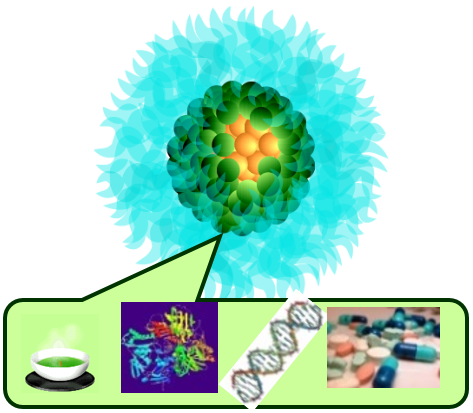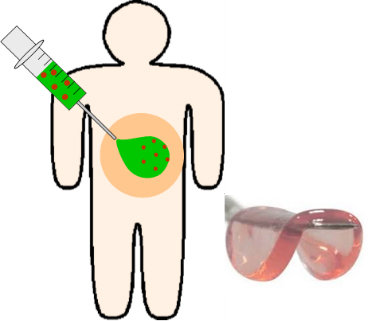
Enhancing Healing Power with Functional Biomaterials
Laboratory on Advanced Nanomedicine and Longevity Creation
Professor:KURISAWA Motoichi
E-mail:
[Research areas]
Biomaterials, drug delivery systems (DDS), nanomedicine, regenerative medicine
[Keywords]
Biodegradable polymers, nanoparticles, green tea catechin, injectable gel system, sustained drug release, drug targeting, cell therapy
Skills and background we are looking for in prospective students
If you have basic knowledge of polymer chemistry, you can start your research without any problems. Still, we will give you profound guidance to play an active role in my laboratory, even if you do not have special knowledge and abilities before enrollment. In short, you can grow as much as you want, depending on your attitude toward daily research activities. To that end, I think it is crucial to create a laboratory where the spirit of mutual prosperity can be shared with research staff and students.
What you can expect to learn in this laboratory
We design, synthesize, and characterize nanoparticles and gels and evaluate whether or not the desired function is sufficient through cell experiments and animal studies. By studying a wide range of fields, you will acquire the basics of various equipments and experimental methods. By the time you complete an animal experiment, you will develop the ability to make detailed experiment plans, discussions, and presentations. It is vital to strive to achieve the research objectives, but we will teach you to acquire the ability to evaluate the experimental results fairly.
【Job category of graduates】
University faculty, postdoctoral fellow, patent examiner, Chemical/pharmaceutical industry
Research outline

Fig.1. Green tea catechin-based
nanoparticle for disease treatment
Our laboratory will develop functional biomaterials that can treat intractable diseases based on polymer science, biomaterials, drug delivery system (DDS) and regenerative medicine. In recent years, advanced medical treatments, including gene and cell therapy, have been implemented, and new treatment methods have been pioneered for diseases that have been considered incurable. Research on biomaterials that support such advanced medical treatment is expected to play an increasingly important role in the development of medical technology that will enable the treatment of intractable diseases in the future. We are developing research collaboration with overseas research institutes such as Singapore, Korea and the United States and promote research and development aimed at clinical application and industrialization.
[Green tea catechin-based nanoparticles as DDS]
pioneered the design of nanoparticles comprised of green tea catechin derivatives for anticancer drug delivery. The green tea catechin has been shown to possess anticancer effects. The green tea catechin-based nanoparticle stably encapsulated anticancer proteins and achieved tumor-selective delivery, dramatically increasing anticancer efficacy from the combinational effects of the carrier and protein drugs, as compared to the drug alone (Fig. 1). The high-performance drug carrier system of the nanoparticle is considered to enable a more effective and safer strategy for cancer therapy, suggesting a scope for an improved nano-medicine formulation. We will further develop the drug carrier system with green tea catechin derivatives to tackle intractable diseases, including cancer and other diseases.

Fig.2. Injectable hydrogel system for biomedical applications
[Injectable hydrogel system for biomedical applications]
We have developed the simple and biocompatible in situ gel-forming system composed of biodegradable polymer-phenol conjugates using a peroxidase-catalysed oxidation reaction (Fig. 2). This gel-forming system allows the formation of hydrogels without any inflammation and redundant reactions with bioactive agents loaded in the hydrogels. In view of the injectable enzymatically crosslinked hydrogel system’s promising properties, our hydrogel is expected to be an important tool in the field of biomaterial science and medicine. The research project involves controlled protein release from hydrogels, immuno-cancer therapy and 2/3D cell culture and differentiation control for cell therapy.
Key publications
- N. Yongvongsoontorn, J. E. Chung, S. J. Gao, K. H. Bae, M. H. Tan, J. Y. Ying, M. Kurisawa, Carrier-enhanced anticancer efficacy of sunitinib-loaded green tea-based micellar nanocomplex beyond tumor-targeted delivery, ACS Nano 13, 7591-7602 (2019).
- K. Liang, J. E. Chung, S. J. Gao, N. Yongvongsoontorn, M. Kurisawa, Highly augmented drug loading and stability of micellar nanocomplexes comprised of doxorubicin and poly(ethylene glycol)-green tea catechin conjugate for cancer therapy, Adv. Mater. 30, 1706963 (2018).
- J. E. Chung et al. Self-assembled nanocomplexes comprising green tea catechin derivatives and protein drugs for cancer therapy, Nature Nanotechnol. 9, 907-912 (2014).
Equipment
UV-visible spectroscopy, NMR, Dynamic light scattering, HPLC, Rheometer, Scanning electron microscope, Cell culture equipment, Animal research equipment
Teaching policy
Our motto is to operate the laboratory in a style that is close to the students. We will strive to improve students' research abilities. When conducting applied research, we will thoroughly discuss the possibility of social contribution with students and provide an opportunity for students to develop their abilities to play an active role as leaders in society. We will expand students' potential by understanding their interests, abilities and individuality. While always being aware of the world's most advanced research, our laboratory is also on the stage, creating an atmosphere where students are intensely conscious of wanting to disseminate to the world.
[Website] URL:https://kurisawa-lab-en.labby.jp/